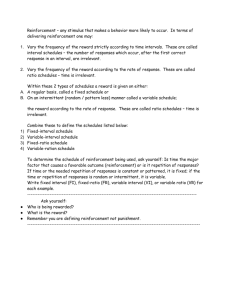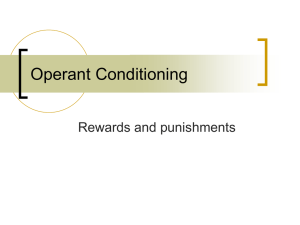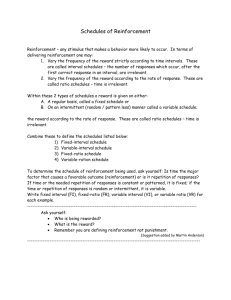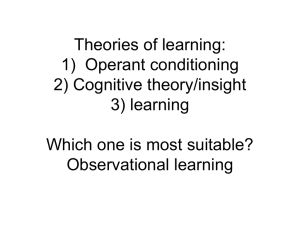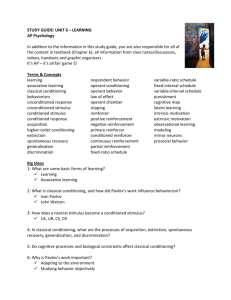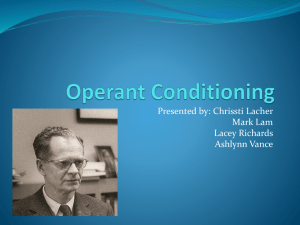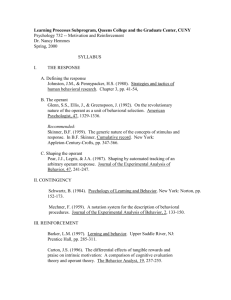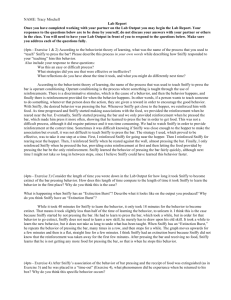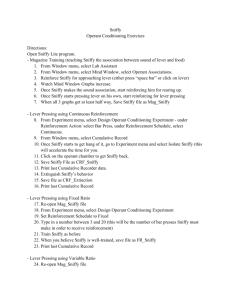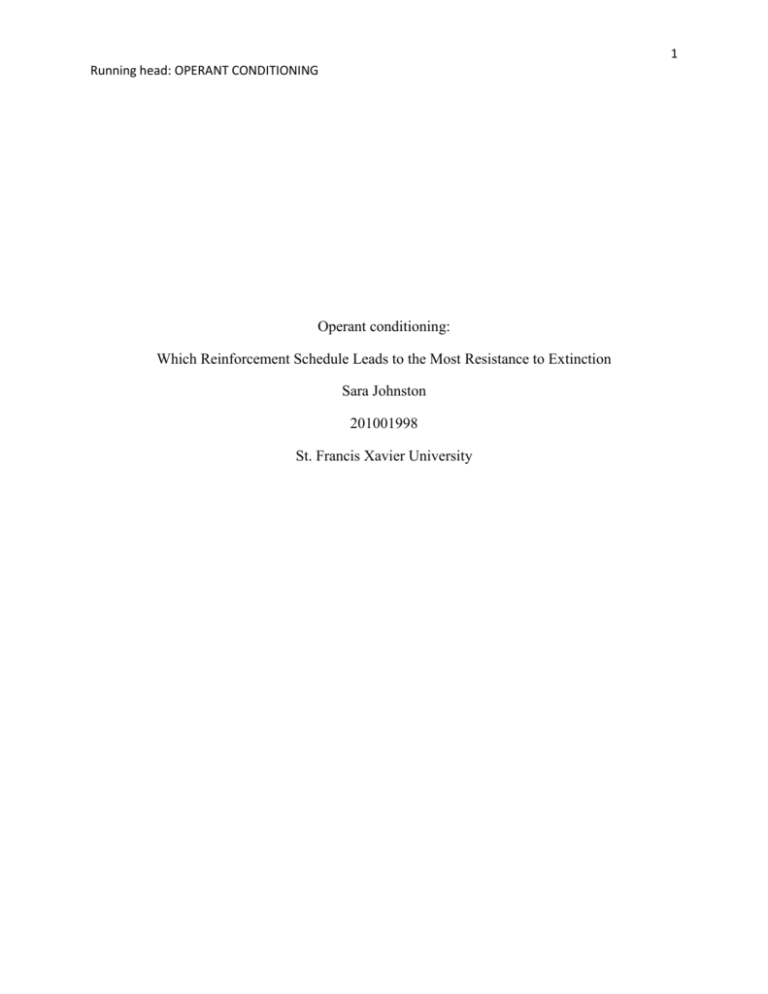
1
Running head: OPERANT CONDITIONING
Operant conditioning:
Which Reinforcement Schedule Leads to the Most Resistance to Extinction
Sara Johnston
201001998
St. Francis Xavier University
2
OPERANT CONDITIONING
1. The two principles associated with operant conditioning, as described by Olson and
Hergenhahn (2009) are: 1) responses are often repeated when they are accompanied with a
reinforcing stimulus and 2) anything that can produce an increase in the rate at which an operant
response occurs is a reinforcing stimulus. It is also explained that operant conditioning is at
times, referred to as “Type R” conditioning because the focus is placed on the response that is
elicited rather than the stimulus (Olson and Hergenhahn, 2009).
2. According to Olson and Hergenhahn (2009), the skinner box is set up like a cage with a grid
floor to keep the animal contained. It includes two components, a lever which is light enough for
the animal to press and a food cup into which the food is dispensed. When the animal presses the
lever, the food is dispensed into the cup, presenting the reward. Skinner kept track of the animals
behavior by means of a cumulative recording device. The cumulative record keeps track of time
on the x-axis and the number of responses on the y-axis. Olson and Hergenhahn (2009) indicate
that as the animal makes bar pressing actions, the line on the record rises. With this we can infer
that the steeper the incline, the more rapid the responses are being made, while a flat line
indicates that there is no action.
3. A constant reinforment schedule (CRF) is a condition in which the animal receives
reinforcement every time the desired response is produced (Olson and Hergenhahn, 2009).
Unlike a CRF schedule, Olson and Hergenhahn (2009) explain that when an animal is being
conditioned on a partial reinforcement schedule (PRF) the desired response (in this case, bar
pressing) is only reinforced part of the time. There are four sub schedules which use PRF method
of scheduling. A fixed ratio schedule (FR) will give the animal reinforcement after a set number
of desired responses are made while a fixed interval schedule (FI) will provide the animal with
3
OPERANT CONDITIONING
reinforcement after a set amount of time has elapsed. Olson and Hergenhahn (2009) go on to
explain that when a variable ratio (VR) reinforcement schedule is used, the animal receives
reinforcement after a certain average of responses have been made. Finally, a variable interval
(VI) reinforcement schedule provides the animal with reinforcement after an average interval of
time has elapsed.
Spontaneous recovery is defined by Olson and Hergenhahn (2009) as the elicitation of a
previously conditioned response to a previously conditioned stimulus following extinction; this
is only spontaneous recovery when no pairings between the conditioned stimulus and the
unconditioned stimulus have occurred following the extinction.
4. Shaping by successive approximation is a method of shaping used in which the animal is
reinforced only to the responses that become similar to the response the experimenter wishes to
produce. This method would be used in the initial stages of training Sniffy to bar press. During
the magazine training sessions, Sniffy would be given manual reinforcements (food pellet) for
being near the bar press. Once Sniffy remained in the vicinity of the bar press, reinforcement
would be given for approaching the bar press, and then for touching the bar press. Finally
through shaping by successive approximation, Sniffy would learn to bar press for food on his
own. (Olson and Hergenhahn, 2009)
5. The schedule of reinforcement presented to the animal has a major impact on the response rate
of bar pressing produced by the animal. This rate differs depending on which type of schedule is
used. CRF schedules will produce a higher response rate but have weaker resistance to extinction
while PRF schedules produces a lower response rate while maintaining a stronger resistance to
extinction. Olson and Hergenhahn (2009) show that during a fixed interval reinforcement
4
OPERANT CONDITIONING
schedule, the animal will begin to bar press at a very slow rate, however, this will gradually
increase as the end of the interval nears. This gradual increase produces an interesting pattern on
the cumulative records which is referred to as the fixed interval scallop. A fixed ratio on the
other hand produces a very high and steady response rate, making the fixed ratio schedule the
best for learning a new behavior. It is observed through the cumulative records that both the FI
and the FR produce a pause in response from the animal immediately after the reinforcement is
delivered, this is called the post reinforcement pause (Olson and Hergenhahn 2009). The variable
interval schedule produces a response rate somewhat slower than that of the fixed interval
schedule, however, it does not produce the scalloping effect. Finally, the variable ratio response
schedule will elicit the highest response rate of all the schedules, the cumulative records of this
schedule show that the pause created by the FR does not occur during the VR schedule.
6. During the first 10 minutes of observing sniffy, five baseline behaviours were noted. Sniffy
drank water from his water dispenser, approached the bar press and even pressed the bar and
received food. Upon receiving this food Sniffy ate it, and then continued to sniff and pace around
the box as if looking for something, perhaps searching for more methods of receiving
reinforcement.
7. Prior to any training, Sniffy’s baseline bar-pressing rate was 0.5 bar presses/min.
8. It took approximately 5 minutes to accomplish magazine training.
9. After completing VR 25 training, it took 15 minutes to reach extinction. During the first two
minutes, Sniffy attempted 38 bar presses.
10. Following completion of VI 25 training, it took 17 minutes to reach extinction. During the
first two minutes, Sniffy bar pressed 20 times
5
OPERANT CONDITIONING
11. Following the completion of FR 25 training, it took 10 minutes to reach extinction. During
the first two minutes, Sniffy bar pressed 89 times.
12. Following the completion of FI 25 training, it took 10 minutes to reach extinction.
13. The results of this study indicate that the FI schedule produced a rate of extinction of 10
minutes, this being the schedule having the least resistance to extinction. Following the FI
schedule from fastest to slowest is as followed: FR- 10 minutes, VR-15 minutes, and VI-17.5
minutes.
Penser (2013) explains that the expected order of results from this study would be as followed
(fastest to slowest) : FI, FR,VI, VR . The FI schedule produces the fastest rate of extinction
because it is not the number of bar presses that have determined reinforcement but rather the
passing of a fixed amount of time. Due to this, the animal has learned how much time must pass
for the reward to present itself, and after this time passes without reinforcement, the animal will
stop bar pressing. A Fixed ratio will also produce a weak resistance to extinction for a similar
reason, when the animal does not receive reinforcement after bar pressing the learned amount of
times, they will discontinue the behaviour. Variable schedules lead to much greater resistance to
extinction, for the animal believes they will eventually be reinforced so they continue the
attempts of bar pressing. A CRF schedule produces the weakest resistance to extinction
compared to the four PRF schedules because during the CFR the animal is given reinforcement
every time, therefore, when reinforcement is not presented during the extinction trials, the animal
almost immediately discontinues its attempts. (E. Penser, Personal Communication, April 1st , 2013)
14. The knowledge of operant conditioning and the various training schedules is important in the
real world for it leads to a better understanding of how to elicit or extinguish certain behaviours
6
OPERANT CONDITIONING
in a more efficient manner. These methods of training can be used in real world situations such
as the workplace or in a teaching setting. In a the workplace, employers may choose either a
fixed interval schedule of pay or a fixed ratio schedule to elicit better suit the type of job. For
example, a teacher may perform better on a fixed interval schedule in which they receive a pay
cheque every set number of weeks. This schedule of reinforcement would produce a sustainable
long lasting career in which the effort put in by the teacher works equally as hard throughout the
year, and a little extra right before pay day. In contrast, a fixed ratio schedule of work may be
more efficient in a production line type job wherein pay is determined by productivity. This
method will produce hard efficient workers, but will also lead to a greater burnout rate. Another
method employers can use to increase productivity is based on a variable interval schedule.
Some employers may check in on employees at random times throughout the day to ensure work
is being completed efficiently and effectively. This varied interval schedule will keep employees
working hard to ensure that their boss does not catch them slacking off.
Having knowledge of reinforcement schedules is also useful for extinguishing a behaviour, for
example variable ratio schedules of reinforcement contributes to gambling addiction. This is
because the gambler is just waiting for that next pay out. Knowing this can help develop
programs for extinguishing this addiction.
7
OPERANT CONDITIONING
Reference:
Olson, M. H., & Hergenhahn, B. R. (2009). An introduction to theories of learning.
Pearson/Prentice Hall.



